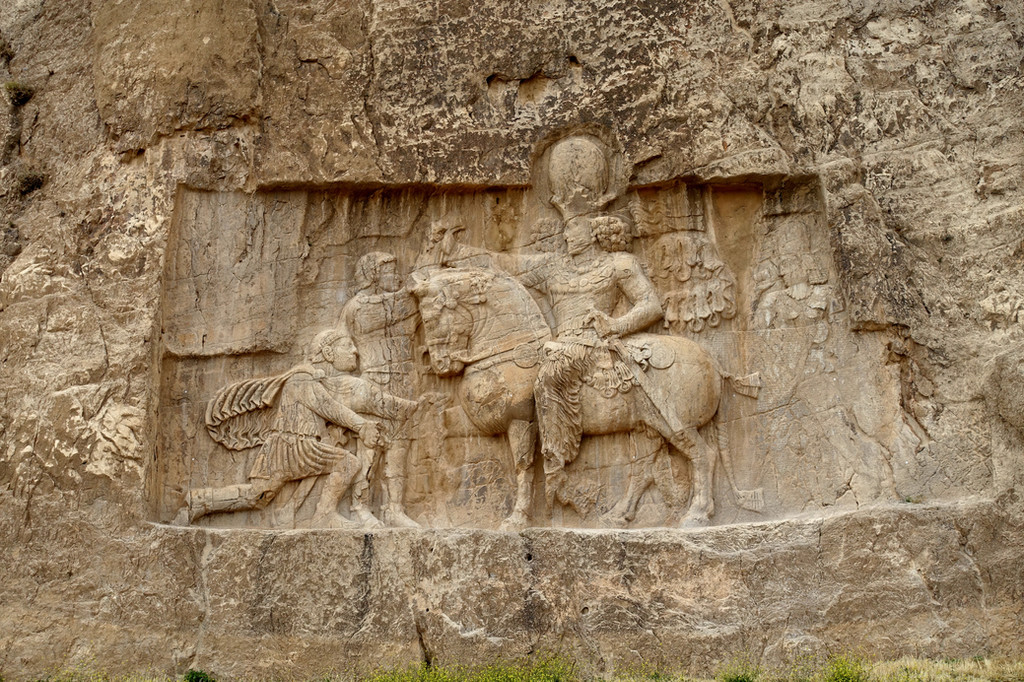HOME | DD
 Syltorian — The Victorious King
Syltorian — The Victorious King

#ancient #antiquity #arab #battle #captive #crown #defeat #emperor #history #horse #horseman #king #peace #persian #philip #photo #photograph #photography #prisoner #relief #rock #roman #rome #sculpture #shah #treaty #valerian #war #sassanid #shapur #sassanian #shahanshah #kartir
Published: 2016-05-17 16:54:29 +0000 UTC; Views: 4409; Favourites: 58; Downloads: 47
Redirect to original
Description
[Download for details]This relief adorns the rocks at Naqsh-e Rostam (نقش رستم), where the old Achaemenid kings were buried. The king shown here ruled much later: he is Shapur I the Great the second of the Kings of Kings (Shahansah) of the Sassanian Dynasty, and he ruled from 240-270 AD.
Shapur inherited a war against Rome from his father, and managed to advance into Syria, where he was pushed back by Gordian III, who invaded Mesopotamia, where he died (possibly in battle) in 244. The Romans chose Philipp the Arab (244-249) as his successor. The new emperor had to move to Rome to establish his power, which gave Shapur the opportunity to ask for a humiliating peace from the Romans - including the relinquishing of any Roman ambitions to control Armenia, and a huge amount of gold. On this relief, Philipp is represented as begging on his knees.
The peace was not to last: neither side was willing to let matters rest. Shapur eventually managed to capture the major Roman city of Antioch, but was again pushed back by the Romans: Emperor Valerian (253-260) recaptured Syria, and met the Persians in battle at Edessa. The battle was a catastrophe as far as the Romans were concerned. They not only suffered defeat, but the Emperor was amongst the captives - something Shapur shows here by holding the hands of the Roman behind Philip.
The Persians went on to push into Asia Minor, deporting some 400'000 people. Unlike the Romans, the Persians were not a major slave-holding society, but instead preferred to resettle prisoners of war within their far-flung empire, though they did use the Roman as expert engineers for various bridges and the dam and the massive water-mill system at Shushtar (photo to follow). The Romans struck back, and managed to capture the royal harem, before being defeated before the capital of Ctesiphon (near Bagdad). Shapur died in 270 AD of an illness. Valerian probably died in around 264, with the sources contradictory on whether he was treated well or abused; he may have lived out his days in relative comfort in the city of Bishapur.
Of note in this relief is the dress of the Roman emperors, famous from Roman sculpture, but above all the King of Kings himself with broad trousers, wide, locked hair, and the massive crown which protrudes from the frame of the relief. Shapur's neck-jewelry and the sword are also well carved (the curved "Persian" sabre or scimitar was not adopted until much later), as is the elaborately cared-for tail of the horse.
The man behind Shapur is possibly the high priest Kartir, who advanced the cause of Mazdaic Zoroastrianism but had Jews, Christians and the Manichaeans persecuted: the Prophet Mani, who had gained some influence, was arrested in 274 AD. He is a later addition to the relief. The inscription which was cut into the tomb is too weathered to read, I think.
The tombs are located in Fars Province, Iran, 12 km from Persepolis.
Related content
Comments: 15

What the carving must have looked like after it was finished.
👍: 0 ⏩: 0

Epic! I would love to see this one day!
Also, I can't wait to see the photos from Shushtar - Roman engineering in the Persian interior is a fascinating thing.
👍: 0 ⏩: 1

Thanks! I've uploaded an image of Shushtar:
👍: 0 ⏩: 0

Wow! And one more time WOW! I hope I will get to see this one day, these reliefs are on the very top of my list of places where I would like to go at least once in my life. They are so beautiful and speak about fascinating stories. It is also amazing that they survived for so long without being defaced or erased like so many other Sassanid monuments.... Thank you for sharing this and, once again, congratulations on the choice of your journey!
👍: 0 ⏩: 1

Thanks! I'm very glad you appreciate these images. Again I can only recommend Iran as a fascinating and hospitable country.
👍: 0 ⏩: 0

Stunning ! The highlights of Sassanian Persia in just one relief !
Can't wait to see your picture of Shushtar.
I knew Roman prisoners had been resettled there but I have never seen what were
the buildings they made in Persia.
👍: 0 ⏩: 1

Thanks!
Shapur knew how to portray himself. I'll try to put up the relief of Bishapur soon. It's very similar, except that Shapur is accompanied by cavalry in side-reliefs... and has the third emperor, the unfortunate Gordian III, lying dead under his horse. Shushtar will follow, too, once I get to sort out which pictures are best - it's a very impressive site.
As for the resettled Romans, there is a theory that some of the prisoners of Carrhae taken by the Parthians ended up on the eastern border, where they were then captured and resettled by the Han Chinese...
👍: 0 ⏩: 1

I vaguely heard about that... How unfortunate were these Romans !
👍: 0 ⏩: 1

Poor guys, especially when the war had been one of the less clever ideas of Licinius Crassus, rather than actually necessary. Still, their fate was better than if it had been the other way around; they may have ended up in a completely unknown part of the world, but at least it wasn't part of a chain-gang in Sicilia, which would have been what the Romans had done to any Parthians unfortunate enough to let themselves be captured.
👍: 0 ⏩: 1

Yes the Romans loved having their slaves close at hand...!
👍: 0 ⏩: 0





























